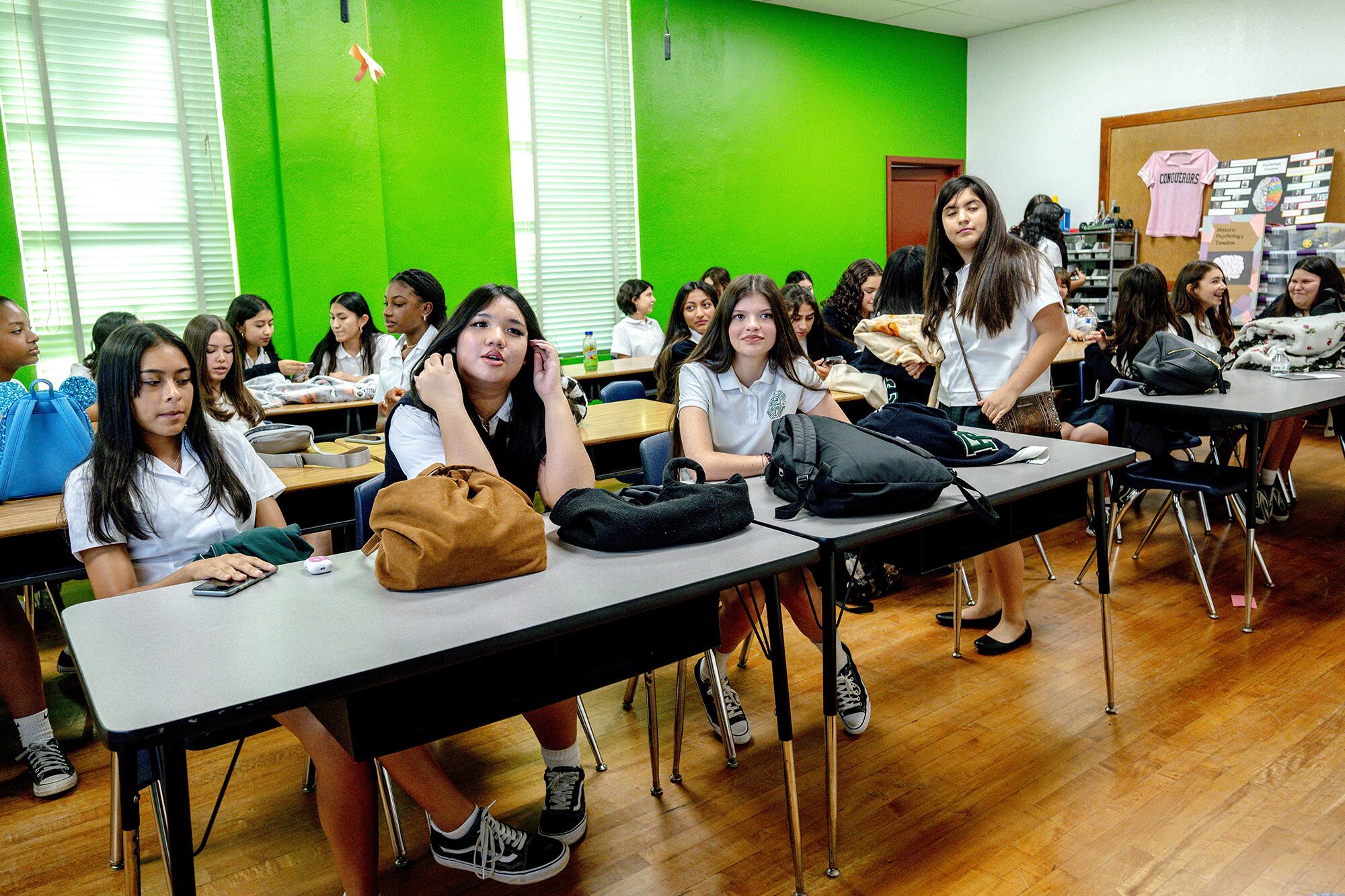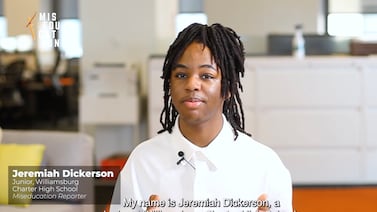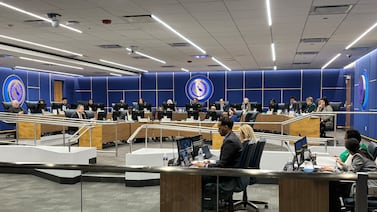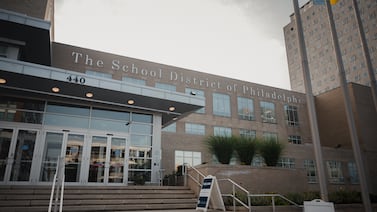Sign up for Chalkbeat’s free weekly newsletter to keep up with how education is changing across the U.S.
A big Republican budget bill in Congress would establish a nationwide, federal school choice program — a potential political breakthrough that conservative lawmakers and advocates have discussed for years but which has consistently stalled.
The $5 billion, 50-state school choice expansion would bring taxpayer-subsidized private school scholarships to dozens of states that have resisted the voucher movement.
The tax-credit scholarship proposal would establish a one-for-one annual tax credit worth up to 10% of adjusted gross income for taxpayers who donate to eligible scholarship-granting groups. That makes the donation essentially free to the taxpayer, with the federal government paying them back.
Longtime proponents of private school choice, who see their movement as expanding educational opportunity, are ecstatic that a federal tax-credit scholarship program has a viable path to become law.
“What it will do is help thousands and thousands and thousands of families with opportunities they never had before,” said Robert Enlow, president and CEO of EdChoice, an advocacy group.
The proposal comes as private school choice has expanded dramatically at the state level in recent years. Texas and Tennessee are among the states that passed universal or near-universal programs this year. Pro-voucher governors tapped outside money to oust anti-voucher rural Republicans from their state legislatures, reshaping the political landscape in favor of private school choice.
At the same time, the increasing polarization of education politics coupled with the questionable track record of voucher programs in improving student outcomes have made private school choice a tougher sell in Democrat-led states. Illinois let its tax-credit scholarship program expire in 2023. And Pennsylvania Gov. Josh Shapiro, who previously expressed support for vouchers, has not backed recent efforts to expand existing tax-credit scholarships in that state.
Although the federal government supports vouchers for District of Columbia students, previous attempts to provide broader backing for school choice have run aground on Capitol Hill. Backers say the rise of the parental rights movement in the aftermath of COVID and growing momentum at the state level have created a political moment where a new federal program is possible.
But supporters like Enlow aren’t popping champagne corks just yet. He said that “we’ve got to see the final version before we say, ‘hey, this is something we really support.’”
Already the bill has been modified to require that schools accept students with disabilities, while still allowing them to maintain their own admission policies. Enlow and other voucher proponents say such requirements would interfere with schools’ independence and deter schools from participating.
Voucher skeptics fear a major change to education policy is side-stepping the normal legislative process, where it would face more debate and scrutiny and where it would be unlikely to earn sufficient votes.
The House budget reconciliation bill includes a host of higher-profile changes to tax policy and major federal programs like Medicaid that have divided Republicans. President Donald Trump and others have said the legislation represents a chance to pass a “big, beautiful bill.”
If enacted, opponents worry it would enable discrimination and further erode the idea of public education as a common good.
“It ends up being a very quiet and sneaky way to fund a voucher program and impose it on states because it’s just wrapped up in this gargantuan and confusing tax bill,” said Jon Valant, director of the Brown Center on Education Policy at the Brookings Institution.
The budget legislation incorporates the tax-credit scholarship program described in the Educational Choice for Children Act, a bill authored by Sen. Bill Cassidy, a Republican who leads the Senate education committee, and other GOP senators.
That bill would require 60 votes to pass the Senate on its own, a near impossibility. A similar proposal in Trump’s first administration failed to get much traction even with Republicans. Including the proposal in the House reconciliation bill as a tax policy means it only needs 51 votes to pass.
How the tax-credit scholarship program would work
For some potential donors to the proposed scholarship program, the tax credit would be quite generous. Taxpayers could donate stock to avoid paying capital gains on investments, saving even more than the face-value of the donation.
While most of the revenue reduction would be borne by the federal government, an analysis from the Institute on Taxation and Economic Policy found that states that tax capital gains would also lose out on millions of dollars.
“This is a tax shelter-voucher hybrid,” said Josh Cowen, a Michigan State University professor who has studied voucher programs and is the author of “The Privateers,” a book about the voucher movement.
Tax credits would be distributed on a first-come, first-serve basis, up to $5 billion a year. Each state would be guaranteed at least $20 million.
Scholarship-granting organizations would distribute the money to eligible students, who could use scholarships not just for tuition but also for books, homeschooling supplies, fees, and educational therapies. These organizations might support certain types of schools, for example Catholic or Jewish religious schools, or serve certain student groups.
Families earning more than 300% of their region’s gross median income would not be eligible. That excludes the most well-to-do families. But an analysis from the Brookings Institution found that threshold would mean wealthy families in areas with high median income would still qualify, while middle-class families in poorer areas might be excluded.
Rural families would be particularly affected because median incomes in rural areas tend to be lower than in urban areas. Rural families also have less access to private schools.
The original tax-credit scholarship proposal from Cassidy called for a $10 billion program, which would have made it one of the larger federal education programs. Title I, which provides extra money to schools serving lots of students in poverty, provides about $18 billion a year, while the Individuals with Disabilities Education Act provides about $15 billion.
Even the $5 billion version included in the House reconciliation bill would be larger than federal spending on charter schools, English language learners, teacher training, and civil rights enforcement combined.
Opponents question why the federal government would throw that much support behind programs that have not consistently improved the test scores of students from low-income backgrounds. (Some studies have found that such students who received vouchers earned a college degree at higher rates than similar peers who stayed in public school, but those studies couldn’t fully account for the fact that voucher students might be different in other ways that benefitted them.)
They fear there won’t be any accountability for whether schools do a good job educating students and that both schools and scholarship-granting organizations would be able to exclude LGBTQ students, those who are not religious, or students with disabilities.
The proposal doesn’t include any requirements that students take tests or that schools meet certain quality standards. It also allows schools to maintain their own admissions policy. For proponents like Enlow, that light regulatory touch is a good thing. Parents need flexibility to find the best fit for their children, and schools need independence to craft their programming, he said.
“We’ve got to make sure that private schools’ voices are being heard so they’ll be there to participate in the program,” he said. “That’s a real key factor.”
In states with vouchers, some parents of students with disabilities report being turned away from private schools. At the same time, EdChoice found that specialized options for students with disabilities expanded in Arizona, where the state offered substantially more money for students who needed special education services. LGBTQ-friendly private schools have also emerged.
Cowen said he doesn’t blame individual parents for using vouchers, but from a policy standpoint, these programs move away from the idea of public schools as places where people from different backgrounds come together.
Greatest impact expected in states without vouchers
The tax-credit scholarship program would supplement state efforts in places that already have education savings accounts or vouchers. But the greatest impact would likely occur in states that don’t have such programs.
When Illinois let its tax-credit scholarship program expire in 2023, organizations like Big Shoulders, which provides scholarships to help low-income families send their children to Catholic schools, had to scramble to maintain support for as many families as possible.
While some individual donors dug deeper, according to Big Shoulders President and CEO Josh Hale, the group has “a lot less” money and is serving fewer students today than a few years ago.
Hale continues to have conversations with Illinois lawmakers about restoring the program. Private school choice often polls well with Black and Latino voters. But it’s an uphill battle politically in a Democrat-controlled state.
A federal program would make more resources available much more quickly.
“Sometimes it’s shown as, this is wealthy people trying to get a break,” Hale said. “I see it as more resources going to underresourced, underrepresented communities, however that shows up. This is to help the least among us find pathways for their children. If that’s an incentive for people to give more, I think we’re all cheering for it here.”
Erica Meltzer is Chalkbeat’s national editor based in Colorado. Contact Erica atemeltzer@chalkbeat.org.






